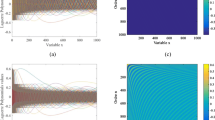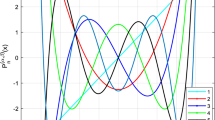Abstract
This paper proposes a scale and rotation invariant recognition method which uses higher-order local autocorrelation (HLAC) features of log-polar image. Linear scalings and rotations are represented as shifts in the log-polar image which is obtained by re-sampling of the input image. HLAC features of log-polar image become robust to the linear scalings and rotations of a target because HLAC features are shift invariant. By combining these features with a simple classifier which uses linear discriminant analysis, we can design a scale and rotation invariant recognition system. Robustness to the scalings and rotations are confirmed by experiments on 2D shapes and face recognition. Robustness to the changes of backgrounds is also confirmed by experiments on face recognition.
Preview
Unable to display preview. Download preview PDF.
Similar content being viewed by others
References
J.Y.Aloimonos and I.Weiss, “Active vision,” International Journal of Computer Vision, pp.333–356, 1988.
D.H.Ballard, “Animate vision,” Artificial Intelligence, Vol.48, pp.57–86, 1991.
G.Sandini and V.Tagliasco, “An anthropomorphic retina like structure for scene analysis,” Computer Graphics and Image Processing, Vol.14, pp.365–372, 1980.
L.Massone, G.Sandini, and V.Tagliasco, “Form-invariant: Topological mapping strategy for 2D shape recognition,” Computer Vision, Graphics and Image Processing, Vol.30, pp.169–188, 1985.
N.Otsu and T.Kurita, “A new scheme for practical flexible and intelligent vision systems,” Proc. IAPR Workshop on Computer Vision, Tokyo, pp. 431–435, 1988.
T.Kurita, N.Otsu, and T.Sato, “A face recognition method using higher order local autocorrelation and multivariate analysis,” Proc. 11th IAPR International Conf. on Pattern Recognition, pp.213–216, 1992.
T.Kurita, “A study on applications of statistical methods to flexible information processing (in Japanese),” Researches of the Electrotechnical Laboratory, No.957, November,1993.
F.Goudail, E.Lange, T.Iwamoto, K.Kyuma, and N.Otsu, “Face recognition system using local autocorrelations and multiscale integration,” IEEE Trans. on Pattern Analysis and Machine Intelligence, Vol.18, No.10, 1996.
I.Sekita, T.Kurita, and N.Otsu, “Complex autoregressive model for shape recognition,” IEEE Trans. Pattern Analysis and Machine Intelligence, Vol.PAMI-14, No.4, pp.489–496, 1992.
T.Kurita, I.Sekita, and N.Otsu, “Invariant distance measures for planar shapes based on complex autoregressive model,” Pattern Recognition, Vol.27, No.7, pp.903–911, 1994.
N.Otsu, “A threshold selection method from gray-level histograms,” IEEE Trans. Systems, Man, and Cybernetics, Vol.SMC-9, No.1, pp.62–66, 1979.
N.Otsu, “Mathematical studies on feature extraction in pattern recognition (in Japanese),” Researches of the Electrotechnical Laboratory, No.818, July, 1981.
T.Kurita, K.Hotta, T.Mishima, “Scale and rotation invariant recognition of 2D shapes and face images using higher-order local autocorrelation features of log-polar image (in Japanese),” Techinical report of IEICE, PRMU96-212, pp.151–158, 1997.
T.Kurita, K.Hotta, T.Mishima, “Scale and rotation invariant recognition of Face images Using Higher Order Local Autocorrelation Features of Log-Polar Image (in Japanese),” Trans. of IEICE, Informatoin and Communication Engineers D-II, Vol.J80-D-II No.8, pp.2209–2217, 1997.
K.Hotta, T.Kurita, T.Mishima, “Scale and rotation invariant recognition of 2-D shape using higher-order local autocorrelation features of log-polar image (in Japanese),” Proceedings of the 1997 IEICE general conference, D-12-229, pp.436, 1997.
O.Hasegawa, K.Itou, T.Kurita, S.Hayamizu, K.Tanaka, K.Yamamoto, N.Otsu, “Active agent oriented multimodal interface system,” Proc. of IJCAI'95, pp.82–87, 1995.
M.Kirby, L.Sirovich, “Application of the Karhunen-Loeve procedure for the characterization of human faces,” IEEE Trans. Patt. Anal. and Mach. Intell., Vol.12, pp.103–108, 1990
N.Kita “Active vision systems using human vision as inspiration”, Trans. of Information Processing Society of Japan, Vol.36, No.3, pp.264–270, 1995
Y.Kuniyoshi, N.Kita, S.Rougeaux, and T.Suehiro, “Active stereo vision system with foveated wide angle lenses,” Proc. of 2nd Asian Conf. on Computer Vision, Vol.I, pp.359–363, 1995.
L.Berthouze, S.Rougeaux, F.Chavand, and Y.Kuniyoshi, “Calibration of a foveated wide-angle lens on an active vision head,” Proc. of CVPR'96, pp.183–188, 1993.
H.Yamamoto, Y.Yeshurun, Martin D.Levine, “Foveated vision system with attentional mechanisms (in Japanese),” Trans.IEICE D-II, Vol.J77-D-II, No.1, pp.119–129, 1994.
J.Van der Spiegel, G.Kreider, C.Claeys, I.Debusschere, G.Sandini,P.Dario, F.Fantini, P.Bellutti, G. Soncini, “A foveated retina-like sensor using ccd technology,” Analog VLSI and Neural Network Implementations, Boston,1989
M.Tistarelli and G.Sandini, “On the advantages of polar and log-polar mapping for direct estimation of time-to-impact from optical flow,” IEEE Trans. on Pattern Analysis and Machine Intelligence, Vol.15, NO.4, pp.401–410, 1993.
M. Kreutz, B. Völpel, and H. Janßen, “Scale-invariant image recognition based on higher-order autocorrelation features,” Pattern Recognition, Vol. 29, No. 1, 1996.
Author information
Authors and Affiliations
Editor information
Rights and permissions
Copyright information
© 1997 Springer-Verlag Berlin Heidelberg
About this paper
Cite this paper
Kurita, T., Hotta, K., Mishima, T. (1997). Scale and rotation invariant recognition method using higher-order local autocorrelation features of log-polar image. In: Chin, R., Pong, TC. (eds) Computer Vision — ACCV'98. ACCV 1998. Lecture Notes in Computer Science, vol 1352. Springer, Berlin, Heidelberg. https://doi.org/10.1007/3-540-63931-4_202
Download citation
DOI: https://doi.org/10.1007/3-540-63931-4_202
Published:
Publisher Name: Springer, Berlin, Heidelberg
Print ISBN: 978-3-540-63931-2
Online ISBN: 978-3-540-69670-4
eBook Packages: Springer Book Archive




